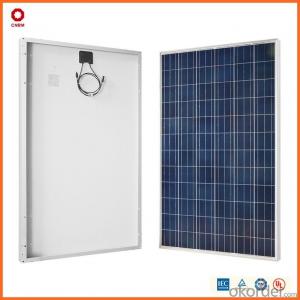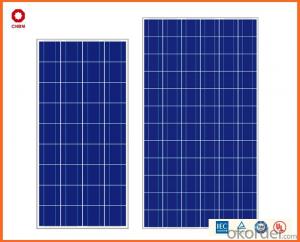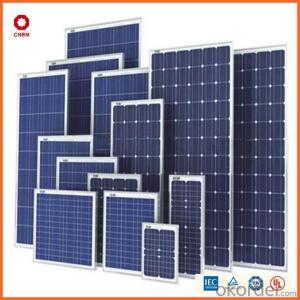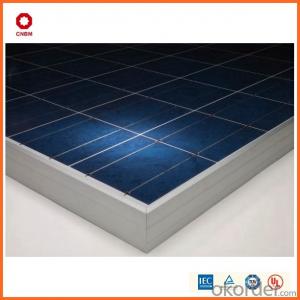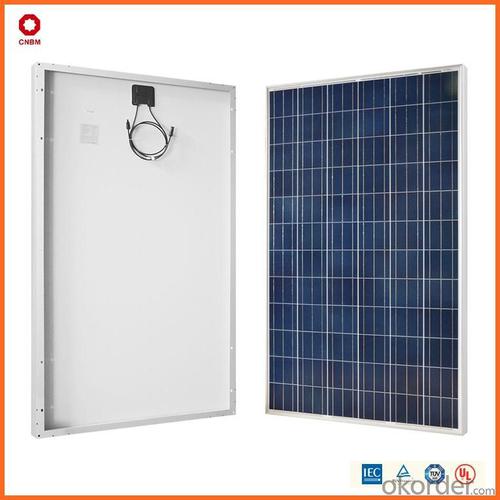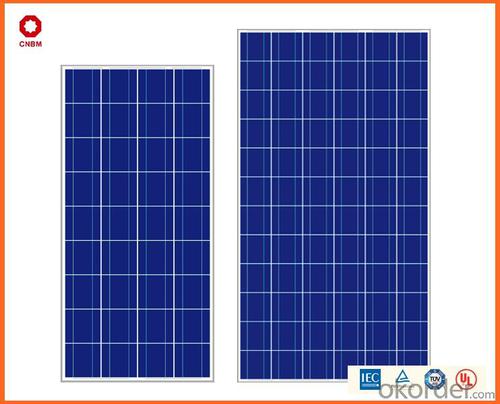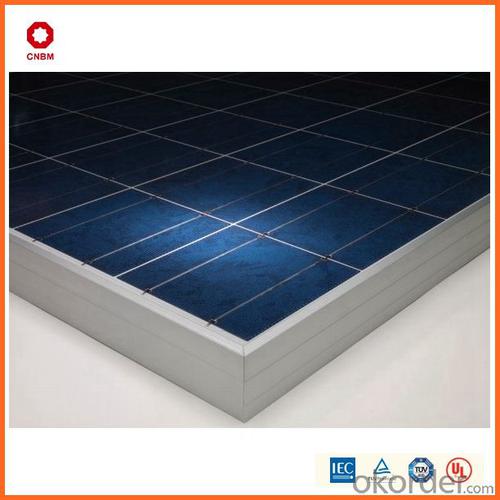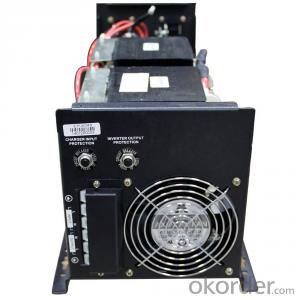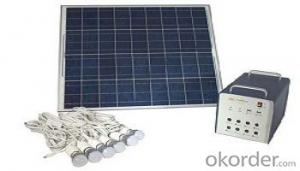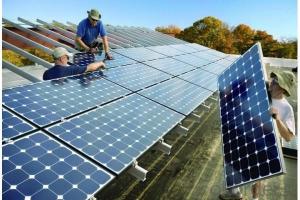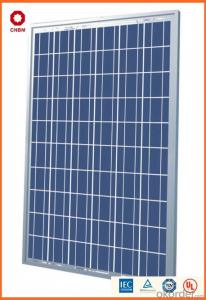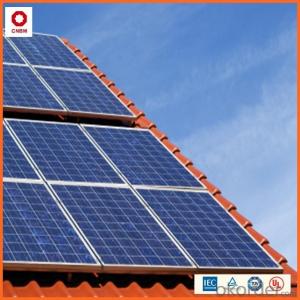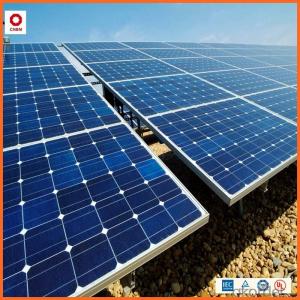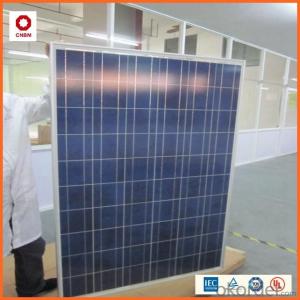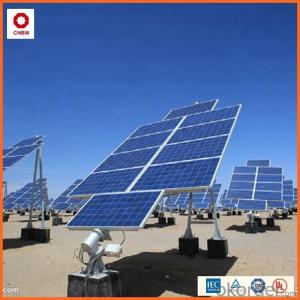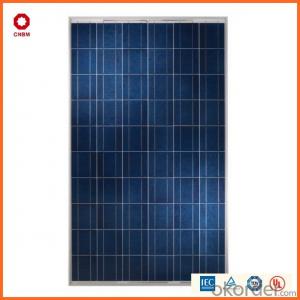Solec Solar Energy Systems - A Grade 255W Poly Solar Panel Hot on Sale at USD0.45/W
- Loading Port:
- China main port
- Payment Terms:
- TT OR LC
- Min Order Qty:
- 1 watt
- Supply Capability:
- 10000000 watt/month
OKorder Service Pledge
OKorder Financial Service
You Might Also Like
Product Description:
Hot Sale !!! Quality and Safety of 245w-320w Poly Solar Panel
1. Rigorous quality control meets the highest international standards.
2. High-transmissivity low-iron tempered glass, strong aluminium frame.
3. Using UV-resistant silicon.
4. IS09001/14001/CE/TUV/UL
Warranties of 245w-320w Poly Solar Panel
1. 10 years limited product warranty
2. 15 years at 90% of the minimal rated power output
3. 25 years at 80% of the minimal rated power output
Technical date of 245w-320w Poly Solar Panel
ITEM NO.: | Mono 125*125 cell ,36pcs . Power range from 80Wp-100Wp | ||||||||
Maximum Power(W) | 80 | 85 | 90 | 95 | 100 | ||||
Optimum Power Voltage(Vmp) | 17.81 | 17.89 | 17.94 | 17.99 | 18.06 | ||||
Optimum Operatige Current(Imp) | 4.78 | 4.91 | 5.12 | 5.35 | 5.59 | ||||
Open Circuit Voltage(Voc) | 21.98 | 22.05 | 22.14 | 22.28 | 22.45 | ||||
Short Circuit Current(Isc) | 4.95 | 5.15 | 5.36 | 5.65 | 5.84 | ||||
Solar Cell: | 125*125 Mono | ||||||||
Number of Cell(pcs) | 4*9 | ||||||||
Brand Name of Solar Cells | JA Cell, Bluesun Cell | ||||||||
Size of Module(mm) | 1580*808*35 | ||||||||
Caple & Connector Type | Pass the TUV Certificate | ||||||||
Frame(Material Corners,etc.) | Aluminium-alloy | ||||||||
Backing (Brand Type) | TPT | ||||||||
Cell Efficiency for 100W(%) | 15.8% | ||||||||
Weight Per Piece(KG) | 12.0KG | ||||||||
FF (%) | 70-76% | ||||||||
Junction Box Type | Pass the TUV Certificate | ||||||||
Tolerance Wattage(e.g.+/-5%) | ±3%, or 0-3% | ||||||||
Front Glass Thikness(mm) | 3.2 | ||||||||
Temperature Coefficients of Isc(%) | +0.04 | ||||||||
Temperature Coefficients of Voc(%) | -0.38 | ||||||||
Temperature Coefficients of Pm(%) | -0.47 | ||||||||
Temperature Coefficients of Im(%) | +0.04 | ||||||||
Temperature Coefficients of Vm(%) | -0.38 | ||||||||
Temperature Range | -40°C to +85°C | ||||||||
Surface Maximum Load Capacity | 2400Pa | ||||||||
Allowable Hail Load | 23m/s ,7.53g | ||||||||
Bypass Diode Rating(A) | 12 | ||||||||
Warranty | 90% of 10 years,80% of 25 years. | ||||||||
Standard Test Conditions | AM1.5 1000W/ 25 +/-2°C | ||||||||
Packing | carton or pallet | ||||||||
1*20' | 25 Pallets / 450pcs | ||||||||
1*40'STD | 25 Pallets / 100pcs | ||||||||
Features of our products:
• High conversion efficiency mono/poly-crystalline amorphous silicon solar cells
• Modules incorporate high performance bypass diodes to minimize the power drop caused by shading
• High transmittance, low-iron tempered glass
• High performance EVA encapsulant to prevent destroying and water.
• AI frame: without screw, corner connection. 8 holes on the frame can be installed easily
• Good performance of preventing from atrocious weather such as wind and hails
• Certifications: CE IEC TUV VDE UL, Class I
• 10 years 90% power output warranty
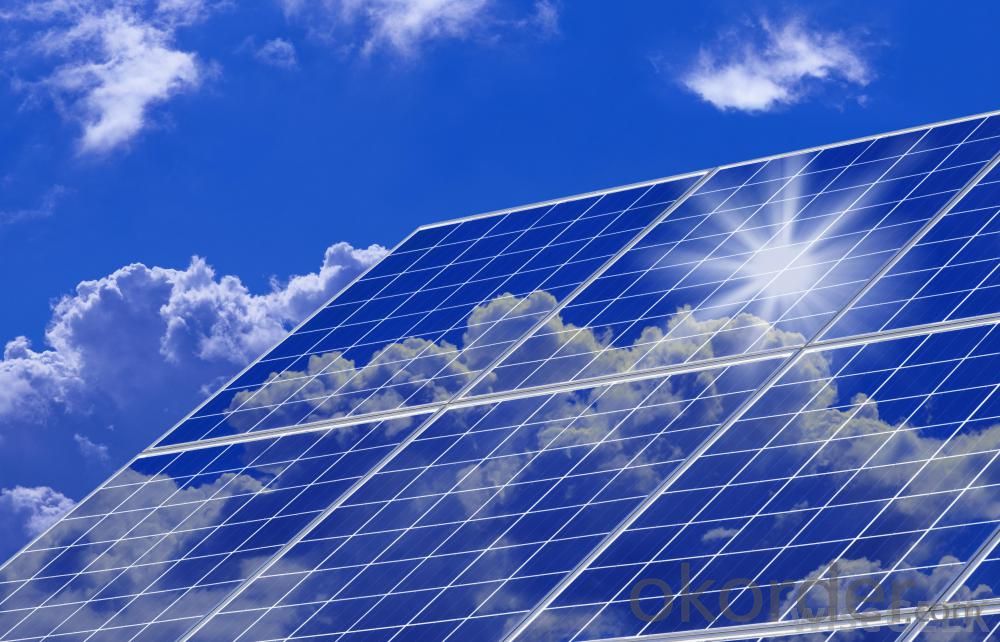
Shipping of 245w-320w Poly Solar Panel
By Sea | Delivery from Shanghai or Ningbo seaport |
By Air | Departure from Shanghai Pudong Airport |
By Express | Post by DHL, EMS, UPS, TNT. |
- Q: Do solar energy systems require regular panel replacements?
- No, solar energy systems do not require regular panel replacements. Solar panels are designed to be durable and can last for decades with proper maintenance.
- Q: Can a solar energy system be installed in an area with a high lightning risk?
- Yes, a solar energy system can be installed in an area with a high lightning risk. However, additional precautions and safety measures must be taken during the installation process to protect the system from potential lightning strikes. This may include installing lightning protection systems, grounding equipment, and surge protectors to minimize the risk of damage.
- Q: How does the cost of solar energy compare to other energy sources?
- Over the past few years, solar energy has become increasingly cost competitive with other forms of energy. In the beginning, solar panels were more expensive due to high installation costs and limited efficiency compared to fossil fuels. However, advancements in technology, economies of scale, and supportive government policies have significantly reduced the cost of solar energy. Currently, solar energy is rapidly becoming more affordable and competitive. In many areas, it is already cheaper than coal and natural gas, which used to be the most cost-effective energy sources. This trend is expected to continue as solar technology improves and becomes more efficient. One of the main reasons for the decrease in solar energy costs is the falling prices of solar panels. Over time, the prices of photovoltaic (PV) modules, the key component of solar panels, have significantly dropped. Additionally, the manufacturing process has become more streamlined and efficient, resulting in cost savings. Moreover, the operational costs of solar energy are relatively low because sunlight, the primary fuel source, is abundant and free. Compared to fossil fuel-based power plants, solar energy systems require less maintenance and have a longer lifespan, leading to lower operating costs in the long run. Government incentives and policies have also played a crucial role in reducing the cost of solar energy. Many countries and regions offer financial incentives, tax credits, grants, and subsidies to encourage the use of solar energy. These initiatives make solar installations more affordable for consumers and incentivize investment in solar technology, driving economies of scale and further reducing costs. In conclusion, the cost of solar energy has become highly competitive with other energy sources due to technological advancements, economies of scale, and supportive government policies. As solar energy becomes more affordable, it is expected to play a significant role in the global energy transition, offering a clean, sustainable, and cost-effective alternative to traditional energy sources.
- Q: Can a solar energy system be installed on a museum or cultural institution?
- Yes, a solar energy system can be installed on a museum or cultural institution. Solar panels can be mounted on the roof or in an open space surrounding the building to harness sunlight and convert it into electricity. This can help the institution reduce its reliance on conventional energy sources, lower its carbon footprint, and potentially save on electricity costs in the long run. Additionally, the installation of solar panels can also serve as an educational display, highlighting the institution's commitment to sustainability and renewable energy.
- Q: Can solar energy systems be installed on sloped roofs?
- Yes, solar energy systems can be installed on sloped roofs. In fact, sloped roofs are quite common for solar panel installations. The angle and orientation of the roof are important factors in determining the efficiency of the solar energy system. Ideally, a sloped roof with a south-facing orientation will maximize the amount of sunlight exposure throughout the day. However, solar panels can still be installed on roofs with different orientations or slopes, albeit with some adjustments in panel placement and tilt angles. It is important to consult with a professional solar installer who can assess the specific roof conditions and design a customized solar energy system that works best for the slope and orientation of the roof.
- Q: What is the impact of hail on the performance of solar panels?
- Solar panels can suffer considerable damage from hail, which can vary depending on the size and velocity of the hailstones, as well as the quality and durability of the panels themselves. One immediate consequence of hail is physical harm to the surface of the solar panels. Cracks or fractures can be created by hailstones in the glass or other protective layers of the panels, compromising their ability to capture sunlight and generate electricity. These damages can also result in water infiltration, further reducing the efficiency and lifespan of the panels. Another effect of hail is the displacement or misalignment of solar cells within the panels. If hailstones strike with sufficient force, they can dislodge or shift the position of the cells, disrupting their optimal alignment and reducing the overall efficiency of the panel. This misalignment can lead to decreased energy production and a decline in performance. Furthermore, hail can damage the electrical connections and wiring within the solar panel system. Hailstones can impact the junction boxes, connectors, and cables, potentially causing them to loosen or break. This damage can result in electrical faults, reduced energy output, and even system failure if not promptly addressed. In areas prone to hailstorms, it is crucial to consider the design and installation of solar panels to reduce potential damage. Many manufacturers offer panels with tempered or reinforced glass to better withstand the impact of hailstones. Additionally, the incorporation of protective measures such as hail guards or covers can help shield the panels from direct hail damage. Regular maintenance and inspection are also essential to promptly identify and address any hail-related damages. Timely repairs or replacements of damaged panels, cells, or electrical components will help restore the performance and efficiency of the solar panel system. Overall, hail can significantly impact the performance of solar panels, potentially reducing energy production and increasing maintenance costs. However, with proper precautions, durable materials, and adequate maintenance, the potential negative impact of hail on solar panels can be minimized, ensuring the longevity and effectiveness of the solar energy system.
- Q: What is the role of batteries in solar energy systems?
- The role of batteries in solar energy systems is to store excess electricity generated by solar panels for use during times of low or no sunlight. This allows for constant power supply and enables the system to operate independently from the grid, increasing self-sufficiency and reliability.
- Q: What are the different types of solar panels used in solar energy systems?
- The different types of solar panels used in solar energy systems include monocrystalline, polycrystalline, and thin-film panels. Monocrystalline panels are made from a single crystal structure, which makes them highly efficient but also more expensive. Polycrystalline panels are made from multiple crystals, making them slightly less efficient but more cost-effective. Thin-film panels are made by depositing a thin layer of photovoltaic material onto a substrate, making them flexible and lightweight, but generally less efficient than crystalline panels.
- Q: How efficient are solar energy systems?
- Solar energy systems are highly efficient as they convert sunlight directly into electricity or heat without any moving parts. With advancements in technology, solar panels have become more efficient, reaching conversion rates of up to 20-25%. However, overall efficiency can vary depending on factors such as location, weather conditions, and system design. Nonetheless, solar energy systems have proven to be a sustainable and reliable source of clean energy.
- Q: What is the lifespan of solar batteries?
- Solar batteries can have varying lifespans depending on multiple factors. Typically, high-quality batteries can last anywhere from 5 to 15 years. However, some batteries have been known to last over 20 years with proper care and maintenance. Several factors influence the lifespan of solar batteries. These include the type and quality of the battery, how much energy is used before recharging (depth of discharge), the frequency of charging and discharging cycles, and overall battery system maintenance. It's important to be aware that solar batteries can experience a decrease in capacity over time, resulting in reduced energy storage capabilities. This gradual decline is referred to as battery degradation. While this is an inevitable process, proper maintenance and care can help slow down the rate of degradation. To prolong the lifespan of solar batteries, it is recommended to regularly monitor the battery's state of charge, avoid deep discharges, and ensure proper ventilation and temperature control. Following the manufacturer's guidelines for maintenance and replacement can also help maximize longevity. In conclusion, investing in high-quality solar batteries and proactively maintaining them can significantly extend their lifespan, ensuring reliable and sustainable energy storage for your solar power system.
Send your message to us
Solec Solar Energy Systems - A Grade 255W Poly Solar Panel Hot on Sale at USD0.45/W
- Loading Port:
- China main port
- Payment Terms:
- TT OR LC
- Min Order Qty:
- 1 watt
- Supply Capability:
- 10000000 watt/month
OKorder Service Pledge
OKorder Financial Service
Similar products
Hot products
Hot Searches
Related keywords
